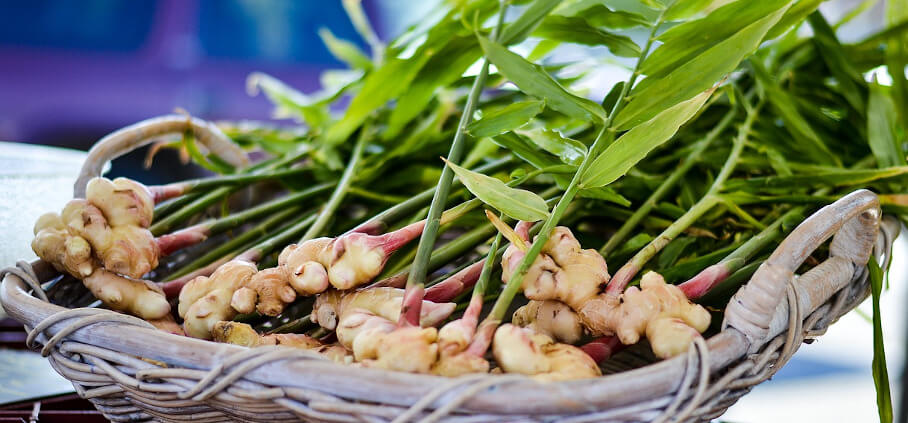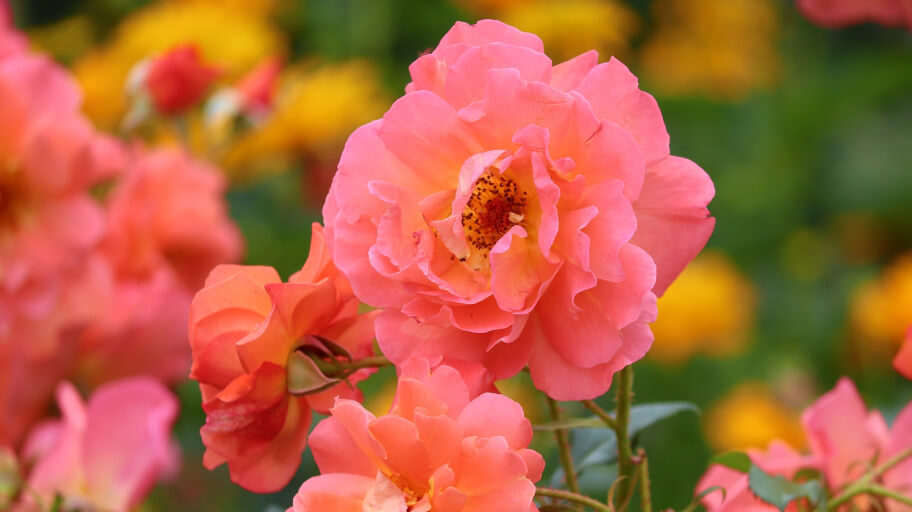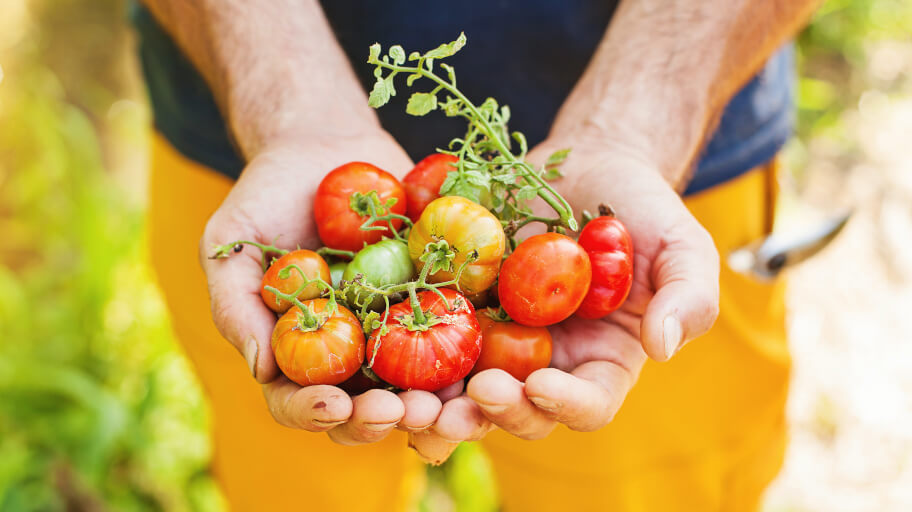
Roots of fresh gingers are an essential part of Asian cuisine. The plant is also widely used both in Chinese and Indian medicine. Looking after ginger is not so hard if you live in a humid and warm place, which is its preferred climate. Therefore, growing your own ginger plant in Australia is certainly possible, as the final product may vary, depending on the climate’s specifics of the place you live in.
So if you want to know more, we’ve prepared a wholesome guide on how to grow and care for ginger just for you!
What you need to know about ginger?
Ginger or Zingiber officinale, which is its botanical name, is a part of the family Zingiberaceae. Other popular spices of this family are also turmeric, galangal and cardamom. The plant’s rhizomes are used both as a spice and as folk medicine. Its mainland is Southeast Asia, and it prefers warm and humid climates.
Growing ginger lets you make use of the plant’s root dried and its leaves powdered, fresh, as an oil or even juice. Ginger is suitable for spicing recipes, in cosmetics and for countless medical properties.
How to grow ginger outdoors
Learning how to grow ginger outdoors in Australia involves acquiring the proper knowledge and skills. The northern states with their warmer and more humid climate are most favourable to grow this plant. Those who live in the warmer parts of Australia can plant their ginger straight into the soil.
On the other hand, Australia’s southern parts, with their cooler climate, can be less favourable. That doesn’t mean that you can’t make it work. While there is a chance of getting a smaller harvest, you can still achieve your goal by simulating tropical conditions and growing your ginger in a pot or another larger container.
When and where is best to plant the ginger?
If you wonder when to plant ginger in Australia, the best time is in the early spring. In case you live in a warmer area, you are lucky since there is no wrong time to plant ginger. Any time of the year would be appropriate in this case.
Ginger species are several and differ. However, they all have one thing in common – almost all varieties prefer moist soil, enriched with extra organic matter. When planted outside, the best ginger growing conditions involve warm and humid places, preferably with partial shade. It’s important for the plant to get 2 to 5 hours of sunlight daily.
Ginger roots can’t develop in places with strong winds, frost and poorly draining soils. Provide enough moisture, especially during the warm seasons. If you plan to grow ginger in the cooler regions of Australia, never leave it wet during the winter.
How to plant your ginger
Here, you will learn how to plant ginger quickly, step by step. The main things you need to do are:
- Preparation – Get a healthy round piece of ginger. Find a well-drained soil, adding compost and rotted manure in it. Choose a sunny or a semi-shaded sunny place for the roots.
- Soaking in water – Next, soak the ginger root in warm water overnight to wash away any sprayed products from it. Then cut it into pieces. Each piece must have at least one bud.
- Planting – Plant the pieces in a container with healthy potting mix with the knobby eyes face up. They should be at least 20 cm apart and 5-10 cm deep into the soil. Simply cover the parts with more mix and water well.
- Transplanting – Once shoots appear, move them with the soil in the pot into your garden at a warm sheltered area in direct sunlight. Water them weekly applying a liquid fertiliser once every two weeks.
As you can see, planting ginger doesn’t need extra skills or advanced knowledge. Follow the above steps taking into account the climate in your area, and you will have success.
Growing ginger in a pot
Growing ginger in a pot is very handy as you can move it to the proper conditions whenever necessary. You can move the pot to a warmer place, keep away from winds at will. People prefer this method since planting ginger in a container offers flexibility.
Here is how to grow an endless supply of ginger indoors:
Step 1: Finding the right container
Choose a pot that can contain 40 litres or more. Keep in mind – the larger, the better. Fill the container with potting soil.
Step 2: Planting
Plant the rhizomes (the plant’s root system with its shoots) about 2 cm below the surface. The growing buds should point upwards. Make sure to water them generously.
Step 3: Creating the perfect environment
Keep the soil moist by covering the pot’s opening with a cling wrap or a plastic bag. This will keep the warmth and moisture inside. After the new shoots pop up above the soil, you can remove the plastic cover.
Step 4: Nurturing your ginger root
Water the pot once per 3-4 days depending on the weather. Be careful not to overwater the young ginger roots, which can quickly rot. To avoid this, ensure good drainage of the container or use a larger one. Water and mulch regularly to maintain the pot moistly.
Knowing how to grow ginger indoors will save you many fruitless attempts and nerves. Before planting, choose young ginger roots, preferably organic ones. They should be tender and plump compared to the store-bought ones, which are often sprayed against sprouting.
How and when to harvest your ginger
If you wonder when to harvest ginger roots, we recommend the winter, which is the most proper time. The exact time depends on the maturity of the root you prefer to get. Mid-flavour ginger is suitable to be harvested when they grow up to 1m height. If you prefer a stronger taste and more spicy hot ginger roots, wait until the plant reaches maturity. The exact time of harvesting ginger depends on how warm the soil is. When planted in warm weather, it may be ready in several weeks.
Considering how to harvest ginger? We can give you a few tips on that:
- Dig around the root to cut off a piece of its mature parts.
- Leave the young root with shoots intact in its active and growing period to resprout.
- During the growing season, you can also dig around the root. Cut part of the older one without disturbing the rest of the plant.
- We recommend leaving the plant to develop fully until the second growing season. Then, you can start harvesting them.
How long does ginger take to grow?
Shoots start to grow on the plant for 4 to 5 months after planting if the soil is warm enough. The rhizomes develop after another 4 months before they are ready for harvest. This means that if you have planted it in spring, the root needs the whole summer to grow fully. In early autumn it will start to die back. So, in late autumn to early winter, you can begin to harvest ginger.
This is generally between 8 and 10 months after planting.
How to best use your organically grown ginger?
Ginger, primarily the organically grown one, has innumerable benefits for health. It can be used in cooking, for teas, desserts and many more purposes. Underground roots and tubers of ginger are some of the most nutritious foods. Organic ginger is packed with minerals and vitamin B.
Besides its incredible nutritional values, ginger root has many health benefits. Here are some of them:
- It improves the absorption of essential nutrients in your body. This makes it an unreplaceable ingredient for your health.
- Reduces inflammation and pain. Thanks to its anti-inflammatory components called gingerols, ginger reduces tissue swelling and pain.
- Eases all kinds of digestive problems and gut inflammation.
- Improves the immune system. Through stimulating healthy sweating, ginger flushes the toxins out of your body.
Takeaways
- Ginger has plenty of beneficial effects on health. It is used in cooking, spicing and cosmetics as well.
- The optimal temperature for growing ginger roots in pots is 25 – 30 C.
- Ginger is ready to harvest after 8 to 10 months, and it is best to leave it to its maximum growth time.
- You can plant ginger both outdoors and in a pot as long as you provide them with enough warmth and moisture. There are still some differences in the cares for potted and outdoor-grown ginger.
- The soil needs to be enriched with nutrients and kept moist.
- Do not overwater the ginger root, especially the young root. Choose young organic roots for planting, which will give you the best harvest.








